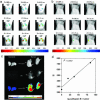Use of gene expression profiling to direct in vivo molecular imaging of lung cancer
- PMID: 16183744
- PMCID: PMC1242291
- DOI: 10.1073/pnas.0503920102
Use of gene expression profiling to direct in vivo molecular imaging of lung cancer
Abstract
Using gene expression profiling, we identified cathepsin cysteine proteases as highly up-regulated genes in a mouse model of human lung adenocarcinoma. Overexpression of cathepsin proteases in these lung tumors was confirmed by immunohistochemistry and Western blotting. Therefore, an optical probe activated by cathepsin proteases was selected to detect murine lung tumors in vivo as small as 1 mm in diameter and spatially separated. We generated 3D maps of the fluorescence signal and fused them with anatomical computed tomography images to show a close correlation between fluorescence signal and tumor burden. By serially imaging the same mouse, optical imaging was used to follow tumor progression. This study demonstrates the capability for molecular imaging of a primary lung tumor by using endogenous proteases expressed by a tumor. It also highlights the feasibility of using gene expression profiling to identify molecular targets for imaging lung cancer.
Figures





References
-
- Branda, C. S. & Dymecki, S. M. (2004) Dev. Cell 6, 7-28. - PubMed
-
- Pelosi, G., Scarpa, A., Manzotti, M., Veronesi, G., Spaggiari, L., Fraggetta, F., Nappi, O., Benini, E., Pasini, F., Antonello, D., et al. (2004) Mod. Pathol. 17, 538-546. - PubMed
-
- Kim, D. H., Kim, J. S., Park, J. H., Lee, S. K., Ji, Y. I., Kwon, Y. M., Shim, Y. M., Han, J. & Park, J. (2003) Cancer Res. 63, 6206-6211. - PubMed
Publication types
MeSH terms
Substances
Grants and funding
LinkOut - more resources
Full Text Sources
Other Literature Sources
Medical
Molecular Biology Databases

